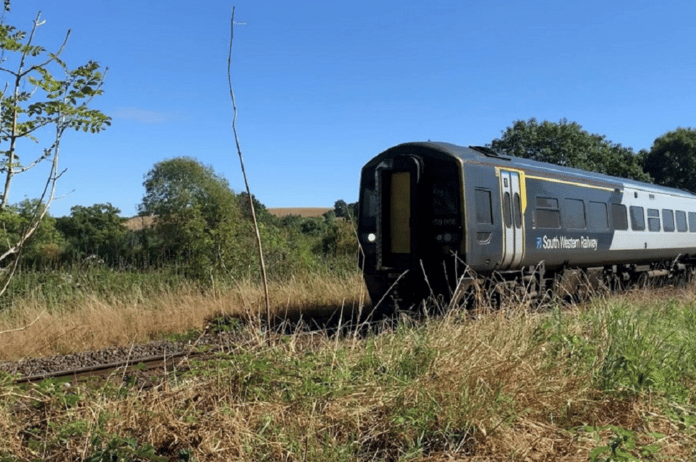After a very soggy few weeks, it may take a bit of work to cast your mind back to the sun-baked days of summer, but remember those scorching hot weeks we endured? Anyone wanting to travel between Salisbury and Exeter St Davids certainly does, as trains have been impacted ever since due to track bed shrinkage!
However, after two months with fewer trains – and lower speeds – services on the West of England line have returned to normal on the South Western Railway line.
Speed restrictions of 40mph were brought in at locations near Tisbury, Gillingham and Axminster, as the clay-based track bed shrank in the record-breaking hot and dry summer, leaving the rails uneven and too bumpy for trains to run at full speed.
Mark Killick, Network Rail’s route director for Wessex, said: “We’re still suffering the after-effects of a record-breaking summer on our railway, but I’m pleased to say that we’re now able to have trains running at full speed again, and I’m so grateful for customers for bearing with us.
“We’ve invested tens of millions of pounds on the West of England Line in the last two years by strengthening railway cuttings and renewing track and switches and crossings. As well as December’s track renewals, we’ve got even more planned in 2023 and 2024, demonstrating our commitment to all of the customers who use this line every year.”
Since the baking heat shrivelled the track bed, engineers have made good progress in restoring the track levels, helped by cooler temperatures and regular (too regular) rain which has stopped the track bed shrinking. As a result, from today (Monday 14 November), Network Rail has been able to lift the speed restrictions and South Western Railway’s (SWR) regular timetable has been restored.
Claire Mann, South Western Railway’s managing director, said: “I am sorry to all those customers whose journeys were affected as we waited for weather conditions to improve to enable Network Rail to safely remove the speed restrictions. We’re looking forward to implementing a full timetable and providing the quality services that our customers deserve.”
The cause of the speed restrictions on the line is known as Soil Moisture Deficit and is caused by largely clay-based soils shrinking in hot and dry conditions as trees and other vegetation soaks the water from them. They shrink unevenly, meaning track laid on top loses its level profile.
There are around 6,000 embankments built from clay in the Southern region of Network Rail with a section in Tisbury – four miles – is the longest. With only a single track for trains in both directions, any delays caused by running slowly mean services going the other way must wait, and delays are compounded.
In a separate project a month later, engineers will return to this area of the West of England Line to renew track and improve reliability. As there is only one track in the area, it means SWR services between Salisbury and Exeter St Davids will be diverted via Westbury between Saturday 10 and Sunday 18 December while work takes place. Buses will serve Tisbury, Gillingham (Dorset), Templecombe and Sherborne.
The focus of the nine-day closure between Salisbury and Yeovil Junction is to replace track in the Gillingham area. Making the most of the closure, engineers will also make improvements at Gillingham and Sherborne stations; improve drainage in the Sherborne, Templecombe and Gillingham areas; perform track maintenance in the Gillingham and Sherborne areas; and remove graffiti and clean litter from the line at Salisbury.
Further closures are planned in November/December 2023 and March 2024, with the Axminster, Crewkerne, Templecombe and Gillingham areas all set for improvements.
Image credit: Network Rail



































 0113 2082620
0113 2082620 info@railbusinessdaily.com
info@railbusinessdaily.com 15 Mariner Court, Wakefield WF4 3FL
15 Mariner Court, Wakefield WF4 3FL

